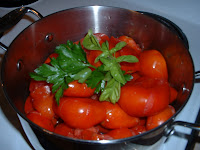
Marinara is an Italian seafood sauce that takes its name from the Italian word "marinaio" meaning sailor. This sauce is traditionally made with garlic and herbs that makes it perfect for the addition of seafood.
When made with fish it’s usually served over linguine, spaghetti or capellini pasta as well as rice.
A modern marinara is a light vegetarian sauce of tomato, onion, garlic, basil and oregano and is often used on pasta and also meat dishes like veal parmigiano.
This sauce can also be used in pasta dishes where vegetables such as green beans or broccoli have been added.
Store bought pasta is basically made from the same ingredients and differ only in shapes and sizes. However if you were brought up in a traditional Italian home you were taught which pasta shape and size complimented which type of sauce…no exceptions and no questions if you please.
For the most part I have to agree with this pasta/sauce rule that has probably stood for centuries but I find a simple tasty Marinara Sauce compliments any shape and size of pasta.
Because there is no meat added to this sauce the cooking time is shorter. If adding fish to the sauce, it can be added a few minutes before it's ready to prevent overcooking the fish.
Clams in Marinara Sauce
4 to 5 cups tomato sauce ( puree)
2 to 3 cloves of garlic
splash of oil (I prefer corn oil)
salt and pepper to taste
basil (fresh or dry)
fresh parsley
12 to 15 Cherrystone Clams
- Heat oil in pan
- Crush or finely mince garlic add to hot oil and saute until golden.
- Add tomato puree, salt, pepper, parsley and dry basil if using and bring up to a boil.
- Lower heat and simmer for 30 to 35 minutes
- If using fresh basil add it just a few minutes before end of cooking time to preserve its flavour.
- Add the clams and when they open the sauce is ready.





Notes, Tips and Suggestions
- Be careful not to burn the garlic as it becomes very bitter and gives the sauce a bitter taste. If by chance you burn it, throw it out and start over.
- I have used marinara sauce, mozzarella and grated parmigiano cheese to layer between lasagna noodles. After baking, plate the lasagna and crown each serving with sautéed shrimp then a generous amount of MarinaraSauce over the shrimp. This makes a great seafood lasagna.
- When adding fish to the Marinara Sauce add at the very end of cooking. Most fish takes very little time to cook and remember that even if you turn off the heat and remove it from the burner the heat of the sauce will continue to cook the fish.
- If adding shellfish, make sure to scrub the shells before using. In the case of clams soak them overnight in salted water to remove any sand particles that may be inside. Drain well and add to the sauce.
- Little Neck, also known as Sauce Clams are also a good choice.
The Art of Pressing and Rolling
Fresh garlic can be sliced, crushed and minced but if you prefer to experience only the taste and not the texture I found the garlic press to do the best job.
The garlic press also helps better release the natural oils and flavour of the garlic.
From experience I’ve found that the press with little teeth that crush the garlic through small holes doesn’t last very long.
If the teeth do not directly align themselves into the holes, repeated use causes damage to the press.
The press with small holes and a flat plate that presses the garlic through works best and wears well also.
Fresh garlic is hard to peel especially if you’re in a hurry. Placing a few cloves into the rubber cylinder and a quick roll with your hand does a quick and neat job of peeling the garlic.
Both tools are rather inexpensive to buy and make the preparation of garlic an easy task.



























